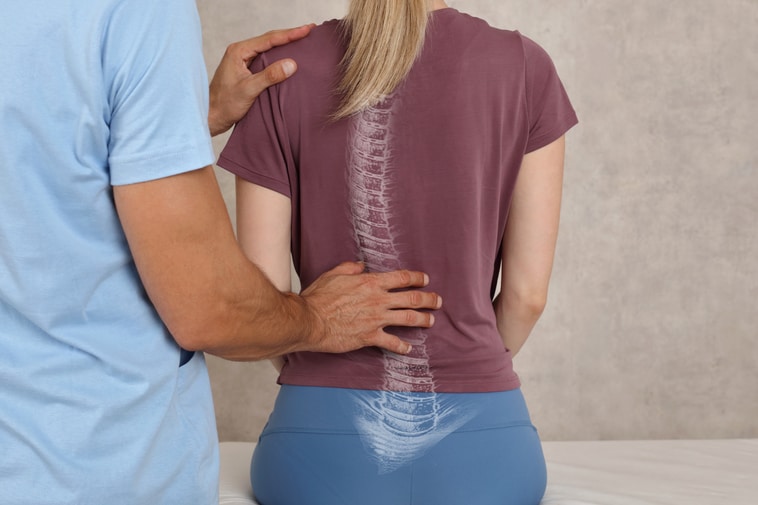Everyone’s spine is curved, but some people have an abnormal curvature of the spine. Normal curvature of the spine gives your body strength and flexibility, but certain conditions can make the spine curve in ways that can cause a lasting impact on your life.
Before looking at the ways that abnormal curvature of the spine can affect your life, and the ways that it can be treated, let’s take a look at some of the types of curvature that one might encounter.
What are the types of spine curvature disorders?
Generally speaking, there are three types of spine curvature disorders, identified by which part of the spine is abnormally curved.
- Lordosis: An abnormal inward curvature of the spine in the lower back is called lordosis, but is sometimes referred to as “swayback.”
- Kyphosis: An abnormal outward curvature of the spine in the upper back is called kyphosis. This causes a slouched appearance and is sometimes referred to as “hunchback.”
- Scoliosis: A lateral curvature of the spine is known as scoliosis. This is a condition where the spine curves sideways.
What causes curvature of the spine?
The causes of an abnormal spinal curve vary by type.
Lordosis may be caused by spondylolisthesis, which we explain, “occurs when one vertebra slips forward relative to another.” It may also be caused by osteoporosis, obesity, or even a tumor.
Kyphosis might be caused by spinal arthritis, which is a “breakdown of the vertebrae” that “is part of the normal aging process, but for some people, it can result in debilitating stiffness and pain or lead to more serious spinal conditions.” WebMD explains that Kyphosis can also be caused by poor posture, congenital conditions affecting the spine, diseases of the spinal cord, and more.
Scoliosis is equally complex. Doctors aren’t sure what causes this type of spinal curvature. As we explain on our Desert Spine & Scoliosis Center of Arizona website, “most cases of non-degenerative scoliosis develop during adolescence for unknown reasons (the medical term for this is idiopathic), although the condition does appear to have a genetic component.”
How the Curvature of the Spine Affects Your Life
As we said above, the gentle curves of the spine are biologically meant to give you strength and flexibility. Abnormal curvature of the spine can cause problems that range from barely noticeable to debilitating.
Back pain
All of the types of curvature of the spine that we have mentioned may cause back pain. Lordosis might cause pain in the lumbar spine, while kyphosis might cause pain in the cervical spine.
Scoliosis may cause no pain at all, especially in children, while the adult form called adult degenerative scoliosis, is more frequently accompanied by pain. The Mayo Clinic explains, “People who had scoliosis as children may be more likely to have chronic back pain as adults, especially if their abnormal curves are large and untreated.”
Breathing problems
Abnormal curvature of the spine can cause breathing problems. As The Mayo Clinic puts it, “in severe scoliosis, the rib cage may press against the lungs, making it more difficult to breathe.”
The same is true for the other forms of spinal curves, which can place pressure on the ribs and lungs.
Fatigue
Lateral curvature of the spine, especially adult scoliosis caused by arthritis, will often cause fatigue. Similarly, the exaggerated curvature of lordosis or kyphosis can cause, or be caused by weakened back muscles, making many forms of activity more difficult.
Balance Problems
Similarly, weakened muscles may cause balance problems across all forms of abnormal curvature of the spine.
Numbness or Tingling
The curving of the spine can cause problems with the spinal column itself, disrupting or compressing the nerves and causing numbness or tingling in the extremities.
How are spine curvature disorders treated?
Each body is different, and every cause of curvature of the spine is unique. That means that there is no one-size-fits-all approach to treating scoliosis’ abnormal lateral curvature of the spine or any other condition. We recommend talking to your doctor if you think you have any of these conditions.
At Desert Spine & Scoliosis Center of Arizona, our approach depends on severity and symptoms. For scoliosis particularly, for both adolescent and adult cases, the continuum of treatment is:
- Wait and see: For most patients without debilitating symptoms, the best approach is to monitor symptoms. Depending on the age of the patient, pain medication and physical therapy may be good options.
- Try a brace: Braces may be employed to help support the back and relieve discomfort.
- Surgery: As a last resort, surgery may be recommended.
If you suspect that you may have a curvature of the spine, Find relief today! Book a consultation.



Recent Comments